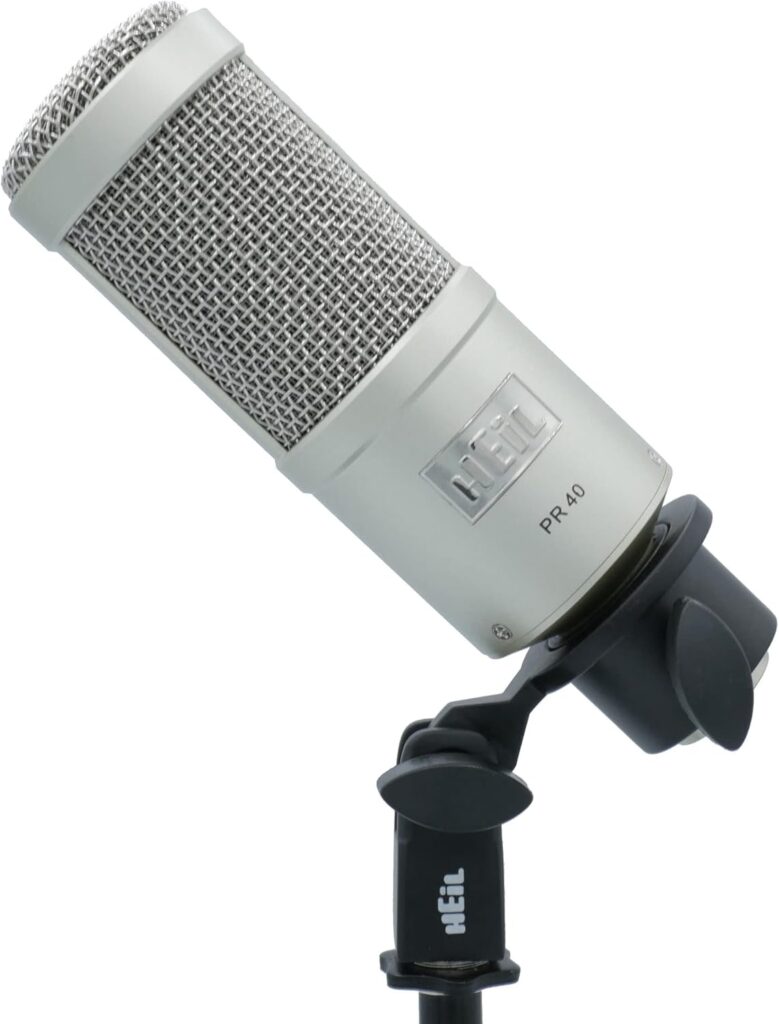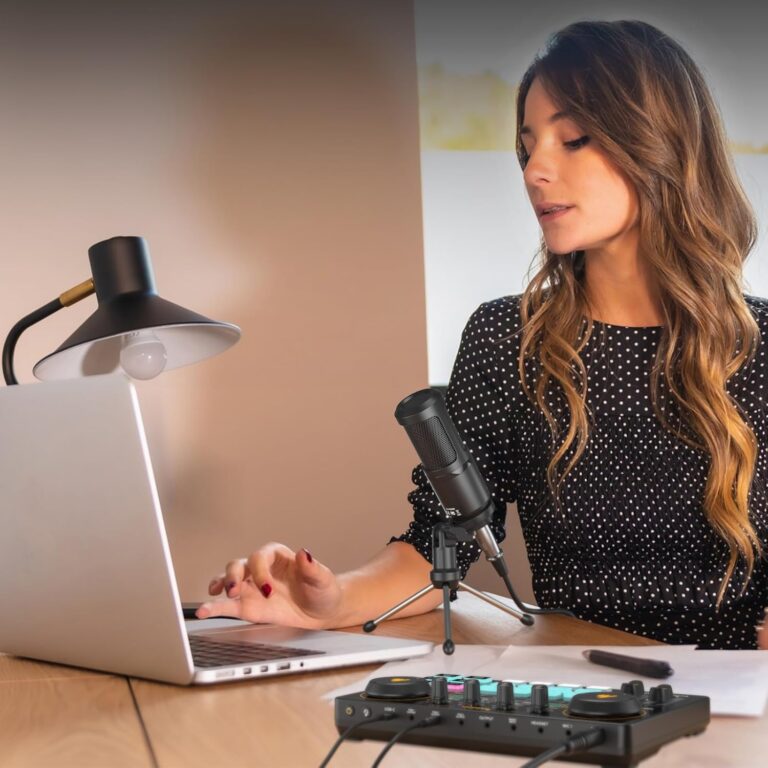Heil PR40 Review
The Heil PR40 is a microphone that has garnered a loyal following among podcasters, broadcasters, musicians, and audio engineers alike. Designed by Heil Sound, a company founded by Bob Heil—a legendary figure in the audio world—the PR40 is often praised for its versatility, robust build, and exceptional sound quality. But does it live up to the hype? In this review, we’ll dive deep into the Heil PR40, exploring its design, performance, applications, strengths, and weaknesses to help you decide if it’s the right microphone for your needs.
Heil PR40 Microphone Review
Microphones are the cornerstone of any audio setup, whether you’re recording a podcast, tracking vocals in a studio, or amplifying a live performance. Among the vast array of options, the Heil PR40 stands out as a dynamic microphone that promises studio-quality sound with the durability and practicality of a workhorse mic. Introduced by Heil Sound, a company with roots in live sound and ham radio, the PR40 has been marketed as a “thoroughbred” in the world of dynamic microphones, boasting a wide frequency range and superior noise rejection.
Design and Build Quality
Aesthetic Appeal
The Heil PR40 is a striking microphone, blending a vintage broadcast vibe with modern craftsmanship. Available in multiple finishes—champagne, black, black with a gold grill, chrome, and gold plate—it’s as much a visual statement as it is a functional tool. The champagne version, in particular, has a matte-finished steel body that exudes sophistication, reminiscent of classic radio mics. Its hefty weight (13.5 oz) and solid construction give it a premium feel, signaling durability right out of the box.
The mic’s end-address design mimics large-diaphragm condensers, but it’s distinctly dynamic in its operation. Dual mesh screens cover the top, protecting the internal components while adding to its rugged aesthetic. Heil Sound even offers custom artwork and logo painting, allowing users to personalize their PR40—a unique touch for those who value individuality in their gear.
Construction Details
Underneath its stylish exterior, the PR40 is built to last. The steel housing is complemented by a Sorbothane shock mount that cradles the large dynamic element, isolating it from vibrations and handling noise. This internal shock mounting is a standout feature, reducing the need for an external shock mount in many scenarios (though one is recommended for optimal performance). An internal humbucking coil further shields the mic from electromagnetic interference, making it safe to use near monitors or lighting fixtures—a boon for live sound engineers and home studio users alike.
The PR40 also features a dual-mesh screen system paired with an internal breath-blast filter, designed to minimize plosives (“p” and “b” sounds) and sibilance. This attention to detail in the design reflects Heil Sound’s decades of experience in audio engineering, particularly in crafting mics that excel in challenging environments.
Accessories
The PR40 comes with a padded leatherette carrying case, a microphone clip, and sometimes a Heil Sound sticker—small but thoughtful inclusions. Optional bundles include the Heil PRSMC shock mount and PL2T boom arm, which enhance its usability for podcasting and broadcasting. While the included clip is functional, many users opt for a shock mount to fully capitalize on the mic’s vibration isolation capabilities.
Sound Quality and Performance
Vocal Performance
The Heil PR40 shines brightest when capturing the human voice. Its wide frequency response delivers a warm, articulate sound with a natural midrange that flatters a variety of vocal tones. Unlike some dynamic mics that emphasize proximity effect (a bass boost when close to the source), the PR40 minimizes this, offering a more consistent tonal balance whether you’re an inch away or a few inches back. This makes it ideal for podcasters and broadcasters who need a polished, professional sound without extensive EQ tweaking.
The internal breath-blast filter does an admirable job of reducing plosives, though a pop filter is still recommended for close-mic’d speech to eliminate them entirely. The mic’s clarity rivals that of some condensers, a testament to Bob Heil’s design philosophy of prioritizing intelligibility—a carryover from his ham radio roots.
Instrument Recording
Beyond vocals, the PR40 excels at capturing instruments with prominent low-end and high sound pressure levels. On kick drums, it delivers a punchy, accurate sound with a rich low-end that doesn’t muddy the mix. The extended frequency response preserves the nuances of the drum’s attack and decay, making it a favorite among studio engineers for percussion.
For bass and guitar cabinets, the PR40 maintains clarity without sacrificing warmth. Its ability to handle high SPLs ensures it can stand up to cranked amplifiers, capturing the full character of the instrument. Users have even reported success with wind instruments and acoustic guitars, though its dynamic nature means it’s less sensitive to subtle transients compared to condensers in those applications.
Noise Rejection
One of the PR40’s standout features is its exceptional rear noise rejection (-40 dB at 180 degrees off-axis). This tight cardioid pattern makes it a go-to for recording in less-than-ideal environments, such as home studios or live stages. Background noise—like air conditioners, computer fans, or audience chatter—is significantly attenuated, allowing the mic to focus on the intended source. This is a key advantage over condenser mics, which often pick up ambient sound in untreated rooms.
Applications
Podcasting and Broadcasting
The Heil PR40 has earned its reputation as a podcasting and broadcasting staple. Its warm, full-bodied sound requires minimal post-processing, saving time for creators who want a professional result straight out of the box. The rear rejection is particularly valuable in multi-mic setups, reducing bleed between speakers—an asset for interviews or co-hosted shows. Pair it with a decent preamp (40 dB of clean gain is recommended), and you’ve got a setup that rivals high-end studio rigs.
Studio Recording
In the studio, the PR40’s versatility shines. It’s a natural fit for vocals, especially for artists with deep or resonant voices, but it’s equally adept at miking drums, bass cabs, and electric guitars. While it may not replace a condenser for delicate acoustic recordings, its ability to handle high SPLs and deliver a clean, uncolored sound makes it a valuable addition to any mic locker.
Live Sound
Live sound engineers appreciate the PR40’s durability and noise rejection. It’s been used on everything from vocals to cannon fire (yes, really—Hollywood sound crews have employed it for explosive effects). The mic’s rugged build ensures it can withstand the rigors of the road, while its tight polar pattern minimizes feedback in noisy venues.
Ham Radio
Given Bob Heil’s background in ham radio, it’s no surprise the PR40 is popular among amateur radio enthusiasts. Its clarity and wide frequency response ensure transmissions are crisp and intelligible, a critical factor in this field.
Strengths and Weaknesses
Strengths
- Versatility: From vocals to instruments, the PR40 handles a wide range of sources with aplomb.
- Sound Quality: The wide frequency response and natural tone rival some condensers, setting it apart from other dynamic mics.
- Noise Rejection: Exceptional rear rejection makes it ideal for untreated spaces or live settings.
- Build Quality: Rugged and reliable, it’s built to last through years of use.
- No Phantom Power Needed: As a dynamic mic, it doesn’t require 48V phantom power, simplifying setups.
Weaknesses
- Price: At around $349 (as of March 2025), it’s not cheap for a dynamic mic, especially compared to budget options like the Shure SM58.
- Gain Hunger: It requires significant preamp gain (40 dB+), which could be an issue with low-powered interfaces.
- Pop Sensitivity: While the internal filter helps, a pop filter is still necessary for close vocal work.
- Not a Condenser Replacement: It lacks the sensitivity and detail of condensers for certain applications (e.g., quiet acoustic instruments).
Heil PR40 vs. Electro-Voice RE20
The Electro-Voice RE20 is a broadcast standard often compared to the PR40 due to its similar applications and extended low-end response. Both mics excel at vocals and kick drums, but the PR40 offers a wider frequency range (28 Hz–18 kHz vs. 45 Hz–18 kHz) and a slightly brighter, more open sound. The RE20, however, has a flatter response and less pronounced highs, which some prefer for a neutral tone. Price-wise, they’re in the same ballpark, though the RE20’s Variable-D technology gives it an edge in reducing proximity effect.
Heil PR40 vs. Shure SM7B
The Shure SM7B is another dynamic mic darling, beloved for its smooth, warm sound and built-in pop filter. The PR40 edges out the SM7B in frequency range and rear rejection, delivering a crisper, more articulate tone. However, the SM7B’s broader popularity and slightly lower gain requirement (thanks to its higher output) make it a safer bet for beginners. Both are premium options, with the PR40 leaning toward versatility and the SM7B toward vocal warmth.
Heil PR40 vs. Rode Procaster
The Rode Procaster is a more affordable broadcast dynamic mic ($229 vs. $349). While it shares the PR40’s focus on voice work and noise rejection, the Heil mic outperforms it in frequency range and SPL handling, making it better suited for instruments. The Procaster is a solid budget alternative, but the PR40 justifies its higher price with superior sound and build quality.
Conclusion
The Heil PR40 is a microphone that lives up to its reputation as a dynamic powerhouse. Its wide frequency range, exceptional noise rejection, and robust design make it a standout choice for podcasters, broadcasters, musicians, and live sound engineers. While it demands a quality preamp and a bit of care to tame plosives, these are minor trade-offs for a mic that delivers such consistent, high-quality results across diverse applications.
If you’re seeking a versatile, professional-grade dynamic mic that can handle everything from spoken word to screaming guitar cabs, the PR40 is a compelling option. It may not replace a condenser for every task, and its price might deter budget-conscious buyers, but for those willing to invest, it’s a tool that rewards with exceptional performance and longevity.
In a crowded field of microphones, the Heil PR40 stands tall—not just as a product of Bob Heil’s innovative legacy, but as a practical, powerful solution for modern audio needs. Whether you’re starting a podcast, tracking a record, or hitting the stage, the PR40 deserves a spot on your shortlist.




